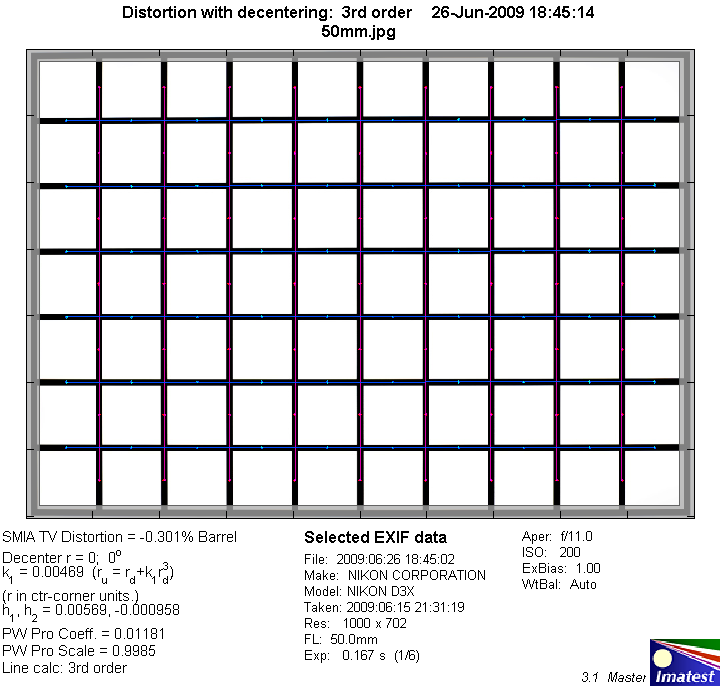|
Page 2 of 3

Distortion
The lens shows a small amount (0.3%) of barrel distortion. This is quite low for a normal prime and of course hardly field-relevant.

The chart above has a real-world size of about 120x80cm.
Vignetting
Typical for most fast primes the Nikkor shows some visible vignetting wide open with a light falloff towards the corners of almost 1.3 EV. As usual, stopping down reduces the corner darkening considerably. From f/2.8 onwards it's no longer an issue except for really critical subjects.
We're performing our vignetting analysis based on
(uncorrected) JPEGs straight from the camera. The JPG engine of the Nikon D3x features a rather flat
gradation curve, thus has a moderate contrast characteristic, resulting in comparatively low vignetting figures - the
corresponding Canon figures are roughly 40% higher due to the more
aggressive default contrast setting.

MTF (resolution)
The center resolution is very good wide open already (but the lens lacks contrast here) and reaches excellent values at f/2.8 and beyond. At f/4 and f/5.6 sharpness is nothing short of outstanding. From f/8 onwards diffraction begins to reduce the resolution values again.
Borders and corners follow a bit behind. Wide open they are barely good, but improve consistently by stopping down. The peak performance is reached at f/8 here.
Please note that the MTF results are not directly comparable across the different systems!
Below is a simplified summary of the formal findings. The chart shows line widths
per picture height (LW/PH) which can be taken as a measure for sharpness.
If you want to know more about the MTF50 figures you may check out the corresponding
Imatest Explanations

Chromatic Aberrations (CAs)
Chromatic aberrations (color shadows at harsh contrast transitions) are moderate and in the range of roughly 0.9 to almost 1.5 pixels, reaching the highest values wide open and slowly decreasing with smaller apertures. This is a good result in the full format scope and not an issue in the field for most subjects. In addition, CAs can easily be corrected in software or by the camera itself (if you shoot JPEGs and own a current Nikon DSLR).

Bokeh
One of the primary usage scenarios for a large aperture lens is to separate the main subject from the background. In such an image the quality of the bokeh (out-of-focus blur) is of major importance.
Good news first: in front of the focal plane the image blur is quite smooth. However, for most subjects this is probably completely irrelevant. Behind the focal plane things are unfortunately a little worse. There is some visible nervousness, the overall impression of the bokeh is a bit unpleasant.
Background highlights are not perfectly circular wide open towards the borders due to mechnical vignetting. Stopped down, the shape of the flat aperture shapes comes through and creates polygons instead of circles. In addition, there is a rather pronounced amount of outlining.

Bokeh Fringing
Bokeh fringing is a common issue with relatively fast glass. It's visible as halos of different colors in out-of-focus areas - magenta (red + blue) in front of the focus point
and green beyond.
Typical for most fast primes, especially ultra fast ones, the Nikkor shows noticeable bokeh fringing at large aperture settings, which can of course be reduced by stopping down.
In addition, these shots also show the lack of contrast wide open, which was mentioned in the MTF section. The issue is emphasized here due to the close focus distance.
|